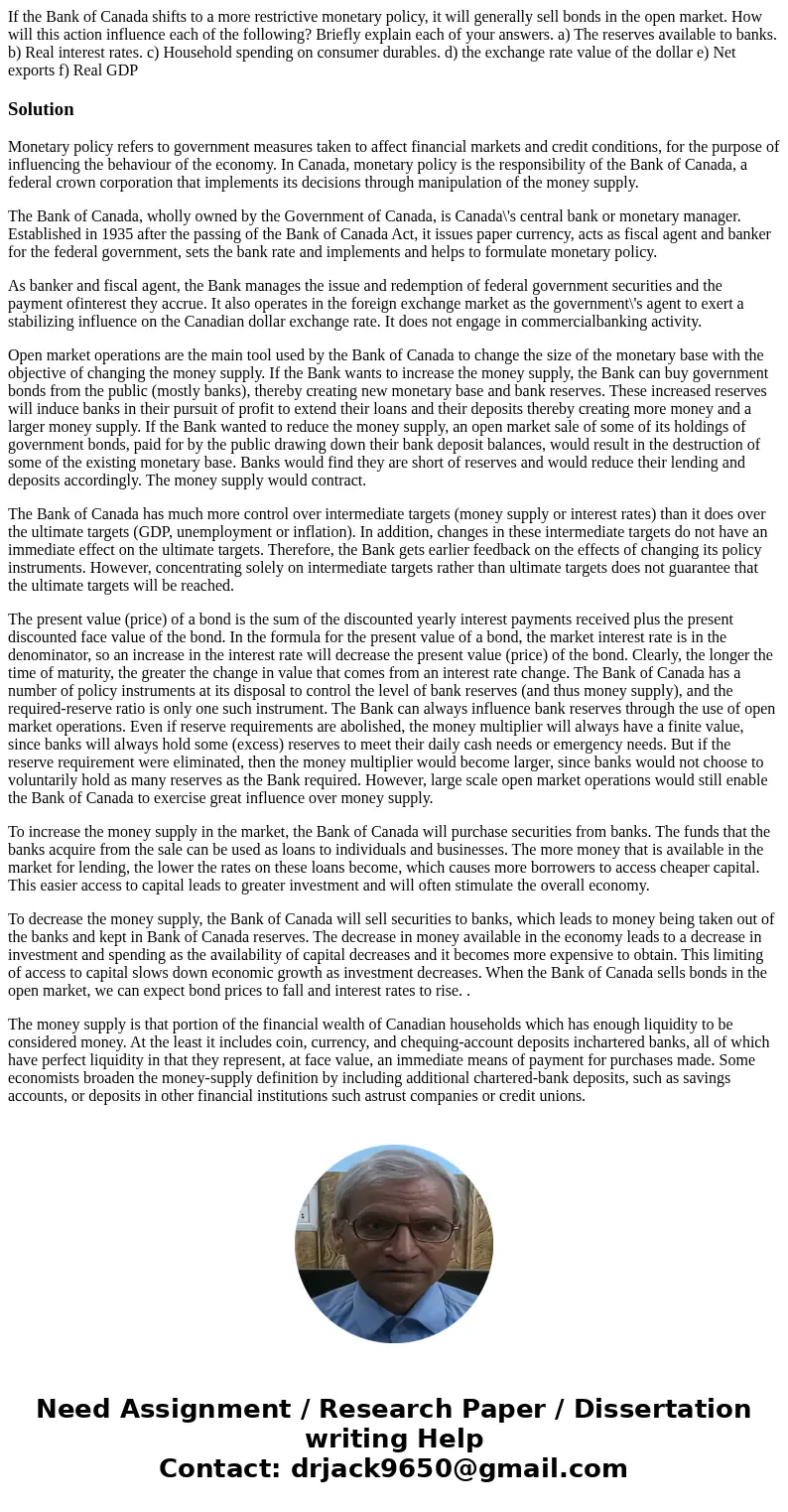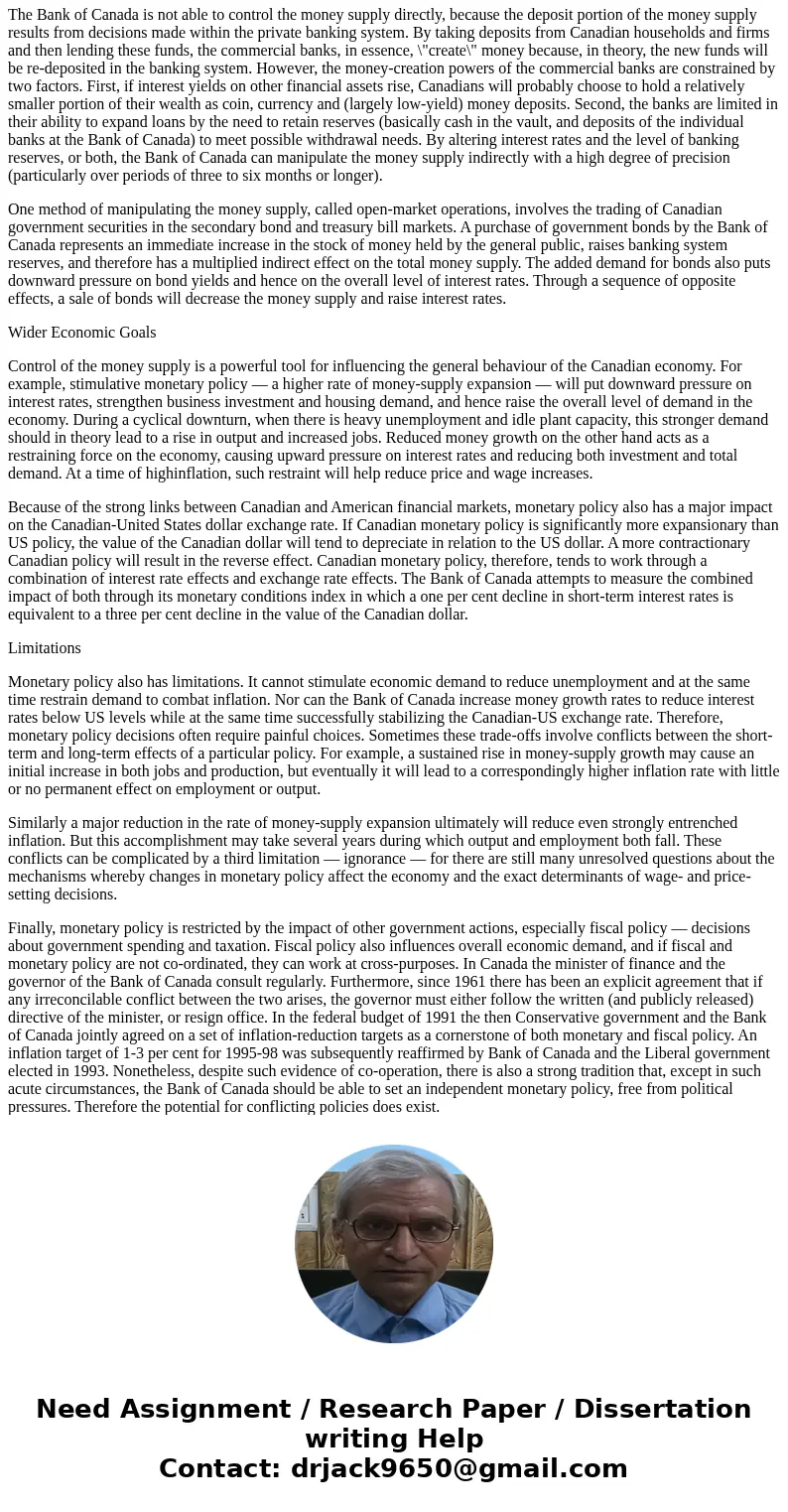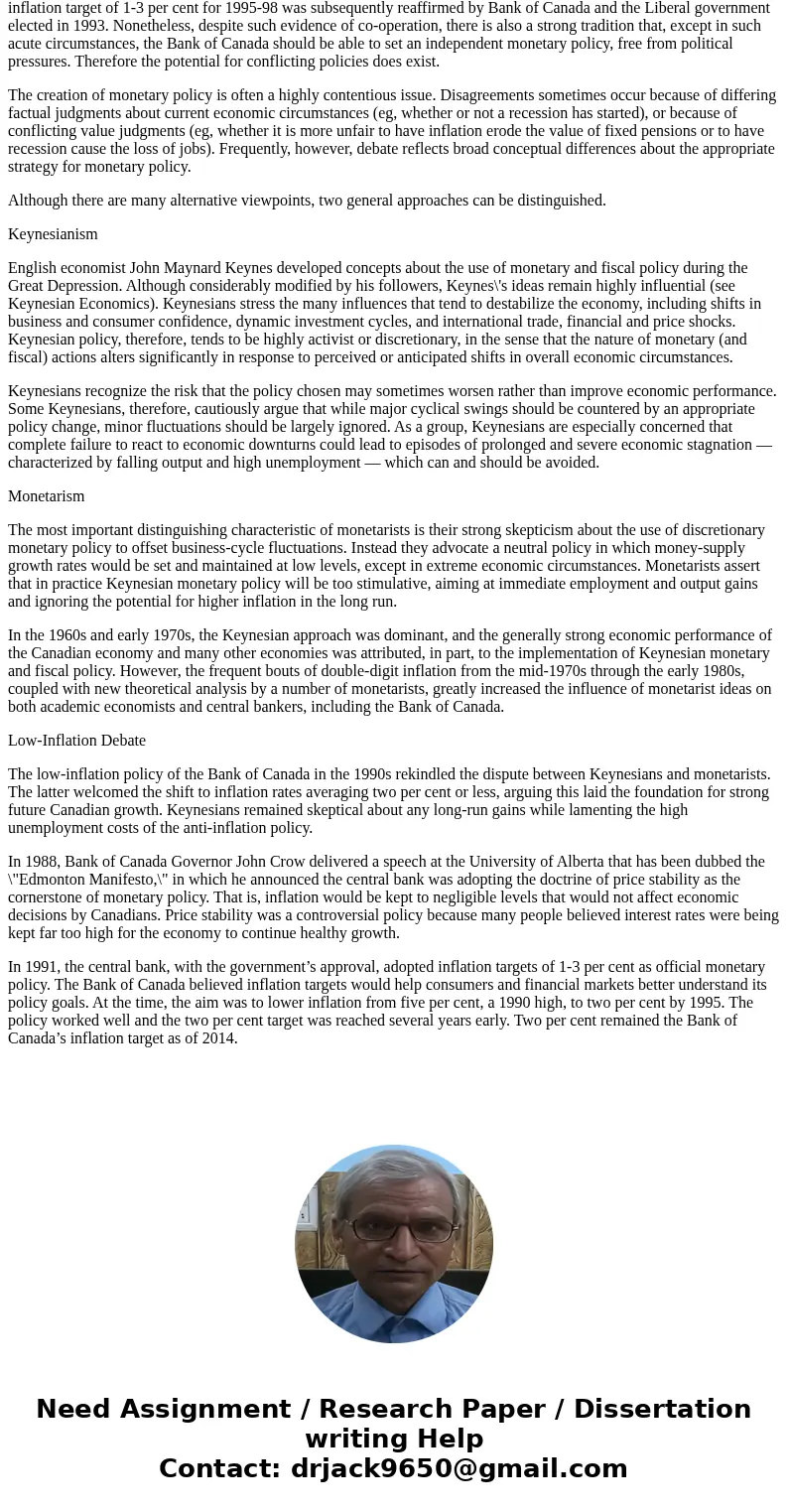If the Bank of Canada shifts to a more restrictive monetary
If the Bank of Canada shifts to a more restrictive monetary policy, it will generally sell bonds in the open market. How will this action influence each of the following? Briefly explain each of your answers. a) The reserves available to banks. b) Real interest rates. c) Household spending on consumer durables. d) the exchange rate value of the dollar e) Net exports f) Real GDP
Solution
Monetary policy refers to government measures taken to affect financial markets and credit conditions, for the purpose of influencing the behaviour of the economy. In Canada, monetary policy is the responsibility of the Bank of Canada, a federal crown corporation that implements its decisions through manipulation of the money supply.
The Bank of Canada, wholly owned by the Government of Canada, is Canada\'s central bank or monetary manager. Established in 1935 after the passing of the Bank of Canada Act, it issues paper currency, acts as fiscal agent and banker for the federal government, sets the bank rate and implements and helps to formulate monetary policy.
As banker and fiscal agent, the Bank manages the issue and redemption of federal government securities and the payment ofinterest they accrue. It also operates in the foreign exchange market as the government\'s agent to exert a stabilizing influence on the Canadian dollar exchange rate. It does not engage in commercialbanking activity.
Open market operations are the main tool used by the Bank of Canada to change the size of the monetary base with the objective of changing the money supply. If the Bank wants to increase the money supply, the Bank can buy government bonds from the public (mostly banks), thereby creating new monetary base and bank reserves. These increased reserves will induce banks in their pursuit of profit to extend their loans and their deposits thereby creating more money and a larger money supply. If the Bank wanted to reduce the money supply, an open market sale of some of its holdings of government bonds, paid for by the public drawing down their bank deposit balances, would result in the destruction of some of the existing monetary base. Banks would find they are short of reserves and would reduce their lending and deposits accordingly. The money supply would contract.
The Bank of Canada has much more control over intermediate targets (money supply or interest rates) than it does over the ultimate targets (GDP, unemployment or inflation). In addition, changes in these intermediate targets do not have an immediate effect on the ultimate targets. Therefore, the Bank gets earlier feedback on the effects of changing its policy instruments. However, concentrating solely on intermediate targets rather than ultimate targets does not guarantee that the ultimate targets will be reached.
The present value (price) of a bond is the sum of the discounted yearly interest payments received plus the present discounted face value of the bond. In the formula for the present value of a bond, the market interest rate is in the denominator, so an increase in the interest rate will decrease the present value (price) of the bond. Clearly, the longer the time of maturity, the greater the change in value that comes from an interest rate change. The Bank of Canada has a number of policy instruments at its disposal to control the level of bank reserves (and thus money supply), and the required-reserve ratio is only one such instrument. The Bank can always influence bank reserves through the use of open market operations. Even if reserve requirements are abolished, the money multiplier will always have a finite value, since banks will always hold some (excess) reserves to meet their daily cash needs or emergency needs. But if the reserve requirement were eliminated, then the money multiplier would become larger, since banks would not choose to voluntarily hold as many reserves as the Bank required. However, large scale open market operations would still enable the Bank of Canada to exercise great influence over money supply.
To increase the money supply in the market, the Bank of Canada will purchase securities from banks. The funds that the banks acquire from the sale can be used as loans to individuals and businesses. The more money that is available in the market for lending, the lower the rates on these loans become, which causes more borrowers to access cheaper capital. This easier access to capital leads to greater investment and will often stimulate the overall economy.
To decrease the money supply, the Bank of Canada will sell securities to banks, which leads to money being taken out of the banks and kept in Bank of Canada reserves. The decrease in money available in the economy leads to a decrease in investment and spending as the availability of capital decreases and it becomes more expensive to obtain. This limiting of access to capital slows down economic growth as investment decreases. When the Bank of Canada sells bonds in the open market, we can expect bond prices to fall and interest rates to rise. .
The money supply is that portion of the financial wealth of Canadian households which has enough liquidity to be considered money. At the least it includes coin, currency, and chequing-account deposits inchartered banks, all of which have perfect liquidity in that they represent, at face value, an immediate means of payment for purchases made. Some economists broaden the money-supply definition by including additional chartered-bank deposits, such as savings accounts, or deposits in other financial institutions such astrust companies or credit unions.
The Bank of Canada is not able to control the money supply directly, because the deposit portion of the money supply results from decisions made within the private banking system. By taking deposits from Canadian households and firms and then lending these funds, the commercial banks, in essence, \"create\" money because, in theory, the new funds will be re-deposited in the banking system. However, the money-creation powers of the commercial banks are constrained by two factors. First, if interest yields on other financial assets rise, Canadians will probably choose to hold a relatively smaller portion of their wealth as coin, currency and (largely low-yield) money deposits. Second, the banks are limited in their ability to expand loans by the need to retain reserves (basically cash in the vault, and deposits of the individual banks at the Bank of Canada) to meet possible withdrawal needs. By altering interest rates and the level of banking reserves, or both, the Bank of Canada can manipulate the money supply indirectly with a high degree of precision (particularly over periods of three to six months or longer).
One method of manipulating the money supply, called open-market operations, involves the trading of Canadian government securities in the secondary bond and treasury bill markets. A purchase of government bonds by the Bank of Canada represents an immediate increase in the stock of money held by the general public, raises banking system reserves, and therefore has a multiplied indirect effect on the total money supply. The added demand for bonds also puts downward pressure on bond yields and hence on the overall level of interest rates. Through a sequence of opposite effects, a sale of bonds will decrease the money supply and raise interest rates.
Wider Economic Goals
Control of the money supply is a powerful tool for influencing the general behaviour of the Canadian economy. For example, stimulative monetary policy — a higher rate of money-supply expansion — will put downward pressure on interest rates, strengthen business investment and housing demand, and hence raise the overall level of demand in the economy. During a cyclical downturn, when there is heavy unemployment and idle plant capacity, this stronger demand should in theory lead to a rise in output and increased jobs. Reduced money growth on the other hand acts as a restraining force on the economy, causing upward pressure on interest rates and reducing both investment and total demand. At a time of highinflation, such restraint will help reduce price and wage increases.
Because of the strong links between Canadian and American financial markets, monetary policy also has a major impact on the Canadian-United States dollar exchange rate. If Canadian monetary policy is significantly more expansionary than US policy, the value of the Canadian dollar will tend to depreciate in relation to the US dollar. A more contractionary Canadian policy will result in the reverse effect. Canadian monetary policy, therefore, tends to work through a combination of interest rate effects and exchange rate effects. The Bank of Canada attempts to measure the combined impact of both through its monetary conditions index in which a one per cent decline in short-term interest rates is equivalent to a three per cent decline in the value of the Canadian dollar.
Limitations
Monetary policy also has limitations. It cannot stimulate economic demand to reduce unemployment and at the same time restrain demand to combat inflation. Nor can the Bank of Canada increase money growth rates to reduce interest rates below US levels while at the same time successfully stabilizing the Canadian-US exchange rate. Therefore, monetary policy decisions often require painful choices. Sometimes these trade-offs involve conflicts between the short-term and long-term effects of a particular policy. For example, a sustained rise in money-supply growth may cause an initial increase in both jobs and production, but eventually it will lead to a correspondingly higher inflation rate with little or no permanent effect on employment or output.
Similarly a major reduction in the rate of money-supply expansion ultimately will reduce even strongly entrenched inflation. But this accomplishment may take several years during which output and employment both fall. These conflicts can be complicated by a third limitation — ignorance — for there are still many unresolved questions about the mechanisms whereby changes in monetary policy affect the economy and the exact determinants of wage- and price-setting decisions.
Finally, monetary policy is restricted by the impact of other government actions, especially fiscal policy — decisions about government spending and taxation. Fiscal policy also influences overall economic demand, and if fiscal and monetary policy are not co-ordinated, they can work at cross-purposes. In Canada the minister of finance and the governor of the Bank of Canada consult regularly. Furthermore, since 1961 there has been an explicit agreement that if any irreconcilable conflict between the two arises, the governor must either follow the written (and publicly released) directive of the minister, or resign office. In the federal budget of 1991 the then Conservative government and the Bank of Canada jointly agreed on a set of inflation-reduction targets as a cornerstone of both monetary and fiscal policy. An inflation target of 1-3 per cent for 1995-98 was subsequently reaffirmed by Bank of Canada and the Liberal government elected in 1993. Nonetheless, despite such evidence of co-operation, there is also a strong tradition that, except in such acute circumstances, the Bank of Canada should be able to set an independent monetary policy, free from political pressures. Therefore the potential for conflicting policies does exist.
The creation of monetary policy is often a highly contentious issue. Disagreements sometimes occur because of differing factual judgments about current economic circumstances (eg, whether or not a recession has started), or because of conflicting value judgments (eg, whether it is more unfair to have inflation erode the value of fixed pensions or to have recession cause the loss of jobs). Frequently, however, debate reflects broad conceptual differences about the appropriate strategy for monetary policy.
Although there are many alternative viewpoints, two general approaches can be distinguished.
Keynesianism
English economist John Maynard Keynes developed concepts about the use of monetary and fiscal policy during the Great Depression. Although considerably modified by his followers, Keynes\'s ideas remain highly influential (see Keynesian Economics). Keynesians stress the many influences that tend to destabilize the economy, including shifts in business and consumer confidence, dynamic investment cycles, and international trade, financial and price shocks. Keynesian policy, therefore, tends to be highly activist or discretionary, in the sense that the nature of monetary (and fiscal) actions alters significantly in response to perceived or anticipated shifts in overall economic circumstances.
Keynesians recognize the risk that the policy chosen may sometimes worsen rather than improve economic performance. Some Keynesians, therefore, cautiously argue that while major cyclical swings should be countered by an appropriate policy change, minor fluctuations should be largely ignored. As a group, Keynesians are especially concerned that complete failure to react to economic downturns could lead to episodes of prolonged and severe economic stagnation — characterized by falling output and high unemployment — which can and should be avoided.
Monetarism
The most important distinguishing characteristic of monetarists is their strong skepticism about the use of discretionary monetary policy to offset business-cycle fluctuations. Instead they advocate a neutral policy in which money-supply growth rates would be set and maintained at low levels, except in extreme economic circumstances. Monetarists assert that in practice Keynesian monetary policy will be too stimulative, aiming at immediate employment and output gains and ignoring the potential for higher inflation in the long run.
In the 1960s and early 1970s, the Keynesian approach was dominant, and the generally strong economic performance of the Canadian economy and many other economies was attributed, in part, to the implementation of Keynesian monetary and fiscal policy. However, the frequent bouts of double-digit inflation from the mid-1970s through the early 1980s, coupled with new theoretical analysis by a number of monetarists, greatly increased the influence of monetarist ideas on both academic economists and central bankers, including the Bank of Canada.
Low-Inflation Debate
The low-inflation policy of the Bank of Canada in the 1990s rekindled the dispute between Keynesians and monetarists. The latter welcomed the shift to inflation rates averaging two per cent or less, arguing this laid the foundation for strong future Canadian growth. Keynesians remained skeptical about any long-run gains while lamenting the high unemployment costs of the anti-inflation policy.
In 1988, Bank of Canada Governor John Crow delivered a speech at the University of Alberta that has been dubbed the \"Edmonton Manifesto,\" in which he announced the central bank was adopting the doctrine of price stability as the cornerstone of monetary policy. That is, inflation would be kept to negligible levels that would not affect economic decisions by Canadians. Price stability was a controversial policy because many people believed interest rates were being kept far too high for the economy to continue healthy growth.
In 1991, the central bank, with the government’s approval, adopted inflation targets of 1-3 per cent as official monetary policy. The Bank of Canada believed inflation targets would help consumers and financial markets better understand its policy goals. At the time, the aim was to lower inflation from five per cent, a 1990 high, to two per cent by 1995. The policy worked well and the two per cent target was reached several years early. Two per cent remained the Bank of Canada’s inflation target as of 2014.



 Homework Sourse
Homework Sourse